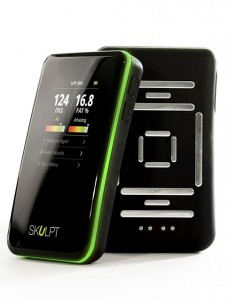Staying in Shape with Science [VIDEO]
-
-
slice.mit.edu
Filed Under
 New technologies and devices that track your steps, food intake, weight, calories, or other health and fitness measurements are everywhere. And while all those may contribute to a healthy and active lifestyle, they’re missing the precision measurements that for Jose Bohorquez PhD ’10, seemed crucial.
New technologies and devices that track your steps, food intake, weight, calories, or other health and fitness measurements are everywhere. And while all those may contribute to a healthy and active lifestyle, they’re missing the precision measurements that for Jose Bohorquez PhD ’10, seemed crucial.So he developed a better way to track fitness progress.
Bohorquez teamed up with Dr. Seward Rutkove, a neurology professor at Harvard Medical School, to start Skulpt in 2009, to track muscular degeneration disorders. Last February they launched Skulpt Aim, the first device that is able to measure muscle quality and fat percentages, as a consumer product. Since their initial focus was medical applications, says Bohorquez, this forced them to be rigorous and focused on reliable, precise technology. “With Skulpt products, people can see within days that they are losing fat and getting stronger. They can see what areas need more work and make their workouts more effective.”
 The device, which is the size of a small smartphone, has 12 sensors on the back, with optimized configurations and frequencies, and uses Electrical Impedance Myography (EIM) technology to evaluate the quality of the muscle and the percentage of surrounding fat. By placing the sensor-side of the device on the muscles you want to measure for about two seconds, the device is able to get data for up to 24 muscles and then show a full-body visualization on the device screen as well as sync to an app on your mobile device.
The device, which is the size of a small smartphone, has 12 sensors on the back, with optimized configurations and frequencies, and uses Electrical Impedance Myography (EIM) technology to evaluate the quality of the muscle and the percentage of surrounding fat. By placing the sensor-side of the device on the muscles you want to measure for about two seconds, the device is able to get data for up to 24 muscles and then show a full-body visualization on the device screen as well as sync to an app on your mobile device.
“Skulpt can tell you how much fat you're losing on specific parts of your body and how much stronger each muscle is getting. If your goal is to get six-pack abs, for example, it's very hard to know what weight to target. By measuring your abs with the Skulpt Aim, you can set a specific, measurable goal: get to 12 percent fat on your abs.”
Bohorquez says the Skulpt Aim is also useful for getting back into shape in general. “Many of our customers are looking for some guidance on what muscles to focus on and a little extra motivation, by seeing progress on what truly matters: fat loss and strength gains.”
Before launching this venture, Bohorquez had already worked at four startups and his entrepreneurial spirit was even more amplified during his time at MIT. “I got exposed to electronics and entrepreneurship as young as 15,” says Bohorquez. “I came to MIT with a good understanding of how the startup world works, what is a Series A, what is fundraising, what are the expectations. And fortunately MIT has a great ecosystem for building entrepreneurs.” Once he met his co-founder at the end of his doctoral studies in engineering, joining forces and starting a company—along with a couple of other MIT students and collaborators—seemed like the obvious thing to do.
Watch a video on Bohorquez and hear his advice for aspiring entrepreneurs: “Borrow scar tissue.”







